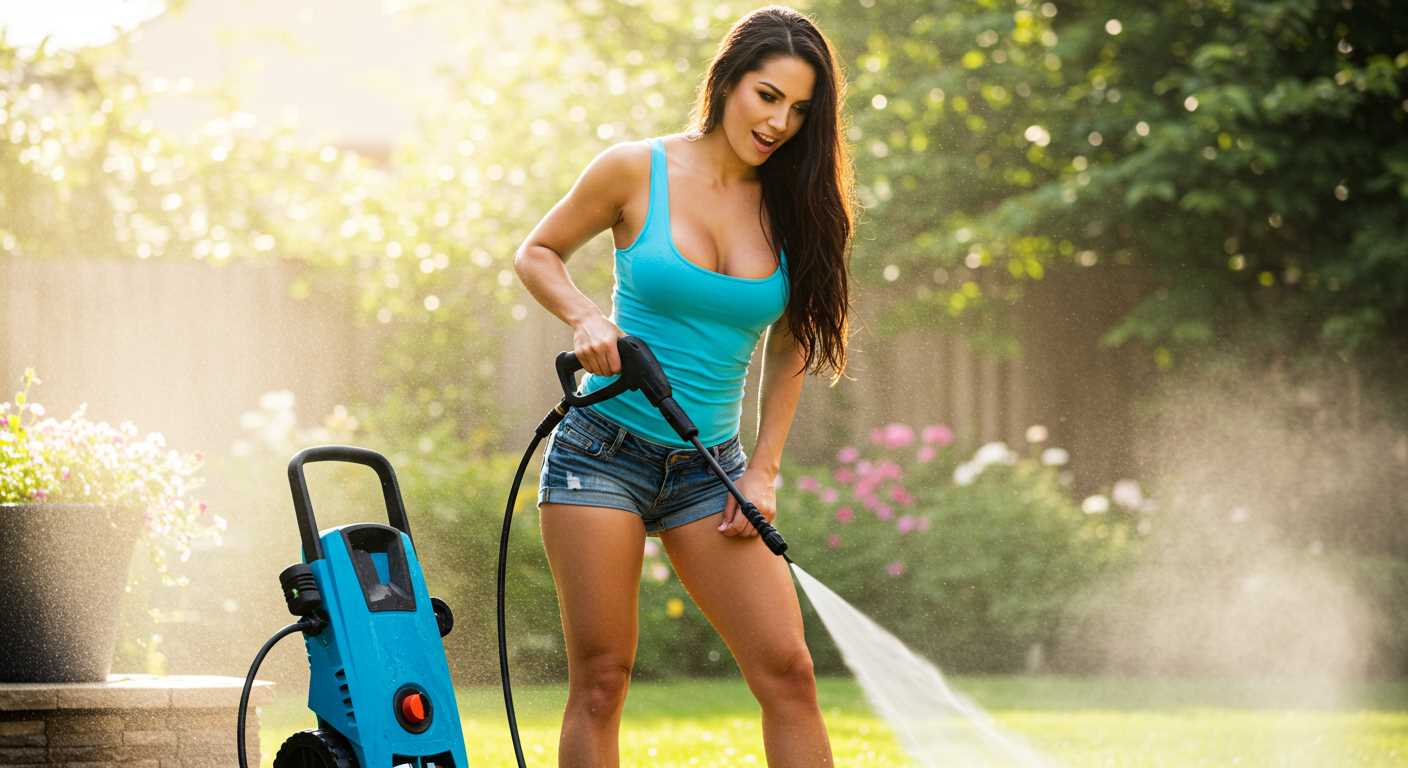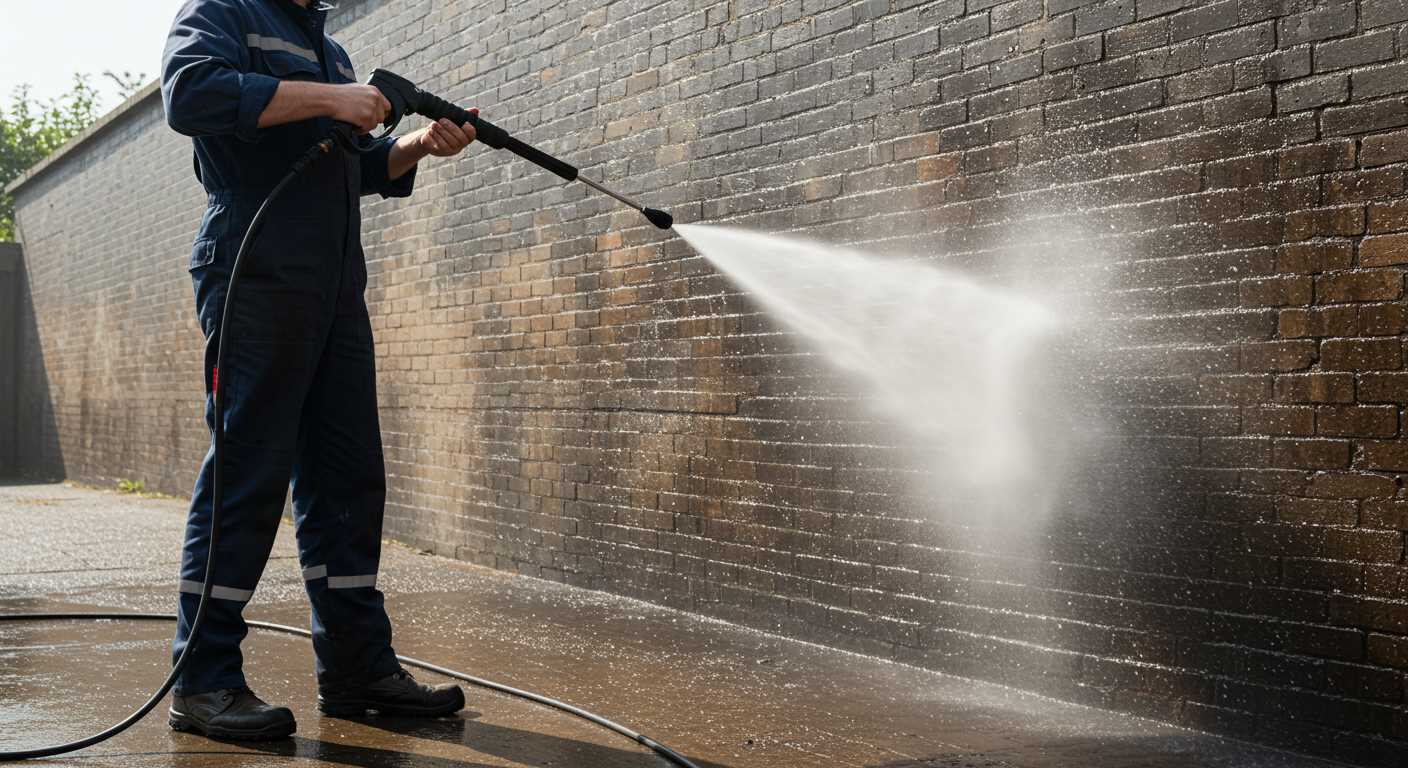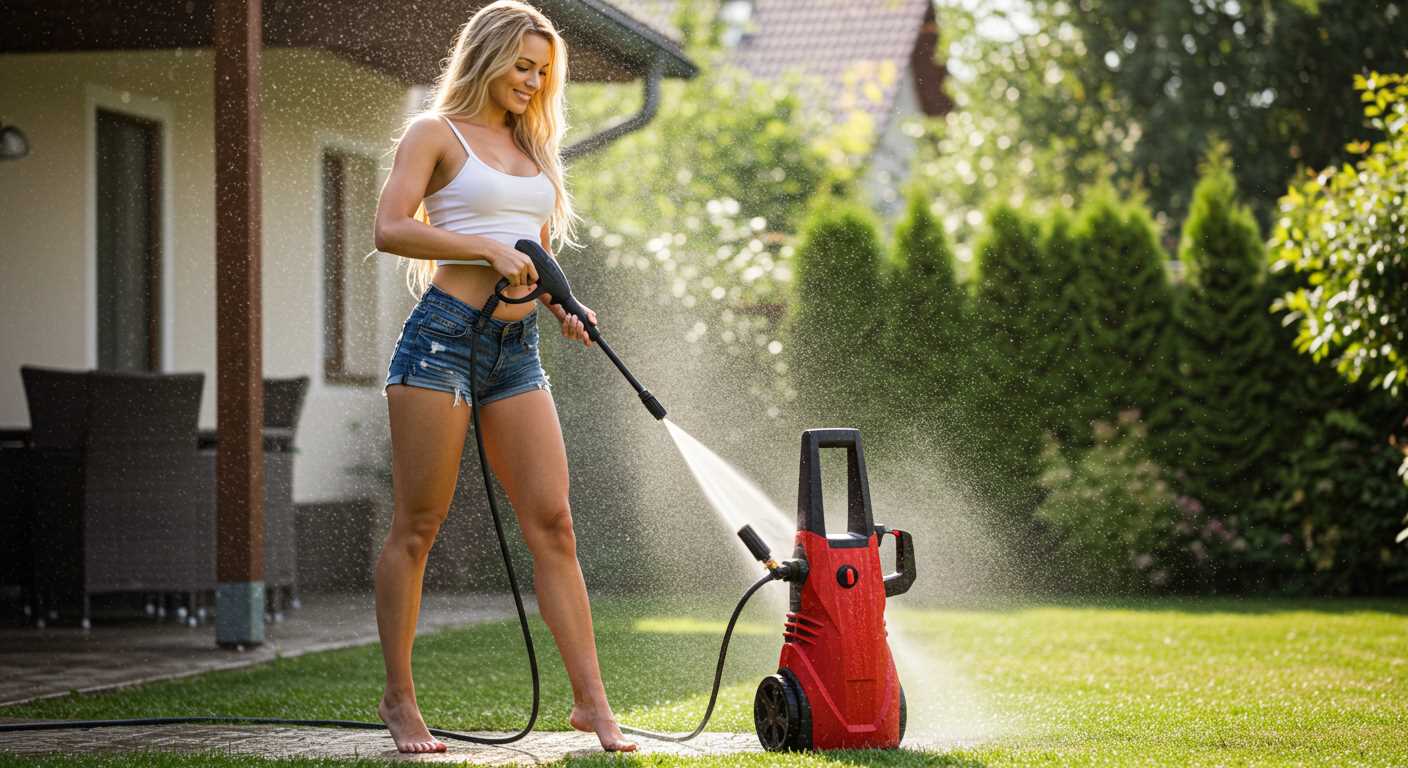



To achieve a spotless finish on your vehicle, select a machine with a minimum pressure of 120 bar for car detailing. This ensures effective removal of grime without damaging the paintwork. Begin the process by rinsing the exterior thoroughly to eliminate loose dirt and debris.
Next, apply an appropriate detergent suitable for automotive surfaces, taking care to follow the manufacturer’s guidelines. Many models have a soap dispenser feature that allows for effortless application. Let the cleaning solution dwell for a few minutes, allowing it to penetrate stubborn stains.
When it’s time to rinse, maintain a distance of approximately 30 centimetres from the surface. This distance protects the paint while providing sufficient force to lift away the soap and dirt. Work from the top down, ensuring even coverage and preventing streaking. For any persistent spots, a gentle scrub with a soft brush or sponge can assist without causing scratches.
Final touches involve drying the exterior with a microfiber towel to avoid water spots and enhance shine. This method not only saves time but also reduces the effort required for manual scrubbing. Mastering these techniques will keep your vehicle looking impeccable with minimal hassle.
Optimal Techniques for Effective Vehicle Cleaning with a High-Pressure Cleaner

Begin with selecting the right nozzle. A fan spray angle of 25 to 40 degrees is ideal for most surfaces, allowing for effective dirt removal without damaging the paint. Always keep the nozzle at least 2 feet away from the exterior to prevent scratches.
Before activation, rinse the entire outer surface thoroughly. This pre-soak helps to loosen embedded grime and debris. Once prepped, apply a dedicated automotive cleaning solution. Ensure even coverage, prioritising areas with stubborn dirt. Allow the solution to dwell for about 5 minutes for optimum results.
After the solution has set, return to the high-pressure spray. Start from the top and work downwards, systematically addressing each section. This method prevents dirt from dripping onto freshly cleaned areas. Maintain a consistent motion to avoid streaks.
Attention to detail is crucial. For regions such as wheel wells and undercarriages, consider using a dedicated attachment designed for those hard-to-reach spots. A concentrated spray in these areas can greatly enhance overall cleanliness.
Lastly, rinse off the detergent thoroughly. Use a lower pressure setting or a wider nozzle to prevent any chance of residual soap. This final rinse leaves the surface clear and ready for drying or further detailing.
Choosing the Right Pressure Washer for Car Cleaning
Opt for a model with a maximum pressure of 1200-1900 PSI. This range effectively removes dirt without risking damage to delicate surfaces. Avoid excessive power; it can lead to scratches and chip paint.
Evaluate the flow rate, ideally between 1.4 and 1.6 GPM. This ensures a sufficient volume of water to rinse soap and grime off without prolonged effort.
Look for a unit equipped with adjustable spray nozzles. Different angles can optimise cleaning for various sections, preventing unnecessary wear on vulnerable areas.
Consider a lightweight design, making manoeuvring around the vehicle more manageable. Pay attention to the hose length; a 20-foot hose allows for plenty of reach without having to reposition the equipment frequently.
Prioritise models that come with essential accessories, such as a foam cannon. This attachment enhances the application of cleaning solutions, providing a thicker layer of foam that clings to surfaces, ensuring better removal of contaminants.
Check for compatibility with detergents specifically formulated for automotive finishes. This enhances cleaning efficacy while protecting the vehicle’s exterior.
Noise levels matter; choose a quieter variant, especially if cleaning in residential areas to avoid disturbing the neighbours.
Lastly, warranty offerings can indicate quality. A longer warranty often reflects a manufacturer’s confidence in their products, safeguarding your investment.
Preparing Your Vehicle for High-Pressure Cleaning

Before starting with the equipment, ensure all windows, doors, and sunroofs are securely closed. This prevents water intrusion into the interior and avoids damage to electronic components.
Remove any personal items and loose debris from both the interior and exterior. Items such as floor mats, child seats, and accessories can obstruct the cleaning process and pose a risk of damage.
Pay special attention to any fragile components, such as side mirrors and antennas. If possible, fold in side mirrors or detach antennas to avoid breakage.
Check for any existing scratches or paint chips. Document and assess these areas to avoid further damage during the cleaning process.
Give the vehicle a thorough pre-rinse with a garden hose to dislodge larger dirt particles. This helps prevent scratching the painted surfaces during the high-pressure phase.
Lastly, be sure to protect sensitive areas, such as the engine compartment and battery terminals, by covering them with plastic or cloth to prevent moisture intrusion.
Selecting the Appropriate Nozzle and Pressure Settings
I recommend opting for a 25-degree nozzle to effectively tackle grime without risking damage to the surface finish. This nozzle strikes a balance, allowing thorough cleaning while maintaining safety.
For tougher stains, such as road tar or bird droppings, switching to a 15-degree nozzle can provide the extra force needed, but be cautious about distance and duration of exposure to prevent any harm.
Adjusting the power output is equally important. If the equipment has variable pressure settings, begin with lower levels. Gradually increase intensity only if necessary, monitoring how the surface reacts during the process.
- Nozzle Types:
- 0-degree: Focused stream for heavy stains; high risk of paint damage.
- 15-degree: Effective for tough spots while maintaining safety; use at an appropriate distance.
- 25-degree: Ideal for general cleaning; offers a wider spray and less chance of damage.
- 40-degree: Gentle mist; suitable for delicate areas, such as chrome and glass.
- Pressure Settings:
- Low Setting: Best for sensitive surfaces like clear coats.
- Medium Setting: Useful for general grime and debris.
- High Setting: Reserved for very stubborn stains; always test first.
Testing the spray on a less visible area first will help gauge both nozzle effectiveness and pressure suitability. This precaution prevents unwanted surprises and ensures a safer and more successful cleaning experience.
Cleaning with Soap: Proper Techniques and Products
Choose a pH-balanced car shampoo specifically formulated for automotive finishes. Avoid household detergents that can strip wax and damage paintwork.
Recommended Products
- Foaming Car Shampoo: Provides an extra layer of suds, allowing dirt and grime to loosen more effectively.
- Wash Mitts: Opt for microfiber or wool wash mitts to prevent scratching surfaces.
- Two-Bucket Method: Use one bucket for soapy water and another for rinsing the mitt to keep contaminants away from the finish.
Application Techniques
- Pre-soak the surface with water to loosen debris before applying soap.
- Apply foam generously, starting from the top and working down to avoid dragging dirt.
- Use a wash mitt in straight lines rather than circular motions to reduce swirl marks.
- Rinse frequently to prevent soap from drying on surfaces.
Ensure thorough rinsing to remove all soap residue, which can leave behind streaks or spots if allowed to dry. After rinsing, dry the surface with a clean microfiber towel to avoid water spots and enhance shine.
Rinsing Techniques That Prevent Damage

A gentle approach is paramount. Begin with a distance of at least two feet from the surface. This ensures that high-velocity streams don’t chip paint or damage delicate components.
Select a wider nozzle, typically a 25-degree or 40-degree option. These create a fan pattern that spreads the flow and reduces pressure on any particular spot.
Position the equipment at an angle rather than directing the stream straight on. This method helps direct water away from seams, electronics, and trim areas, preventing potential issues.
Adjust the output to a lower setting for sensitive areas, such as plastic bumpers and painted surfaces. This cautious setting avoids unnecessary abrasion and gives better control.
Continue rinsing from the top down, working in sections. This systematic technique ensures that water flows downwards, removing dirt and preventing spots from forming.
After the initial rinse, maintain the water flow until the end of the process. This reduces the chance of residue drying on the surface, which can lead to unsightly streaks.
Refrain from using any cleaning agents during rinsing unless indicated otherwise. Chemicals can leave residues that interact unfavourably with water streams, leading to unwanted marks.
Finally, always inspect the surface for any missed spots or stubborn grime before finishing. Correcting these with a soft cloth or mitt ensures a thorough finish without causing harm.
Drying Methods After Pressure Washing
Utilising a microfibre towel is my top pick for achieving a streak-free finish. The soft texture effectively absorbs moisture while minimising the risk of scratches. Gently blot rather than wipe to avoid swirls in the paintwork.
Another efficient strategy is to use an electric blower. This tool is particularly useful for drying hard-to-reach areas, such as wheel arches and behind side mirrors. The high airflow helps displace water without physical contact, preserving the surface integrity.
For those preferring a more traditional approach, a chamois or synthetic alternative works well. They hold significant amounts of water and can be spread across surfaces quickly. It’s advisable to wring them out regularly to maintain drying efficiency.
Finishing with a ceramic or hydrophobic spray can enhance water behaviour on the surface. These products create a protective barrier, allowing any residual moisture to bead off. This not only aids in drying but also provides ongoing protection against contaminants.
In case of inclement weather, choosing a covered area for drying can prevent water spots. Additionally, employing a drying aid specifically designed to facilitate the process can provide extra assurance against marks left by water remaining on the surface.
Finally, consider creating a drying routine that incorporates multiple methods to cover all bases. This layered approach not only speeds up the process but also ensures that every part receives adequate attention, contributing to a polished appearance.
Maintaining Your Pressure Washer for Future Use
Regular upkeep guarantees optimal functionality. After each session, disconnect the nozzle and wand, allowing any residual water to drain. This step helps prevent corrosion and clogging.
Inspect hoses for any damage or wear. Minor issues can lead to significant leaks, so replace frayed or cracked hoses immediately. Store hoses coiled to prevent kinks which can restrict water flow later.
Clean the filter screen. A dirty filter reduces performance. Remove it and rinse under clean water; if heavily soiled, a mild detergent can help. Ensure it dries completely before reassembling.
Check the oil level in gas-powered units. Change the oil as recommended by the manufacturer. Use the appropriate grade to ensure engine longevity.
Inspect all connections, including those linked to the motor. Tighten any loose screws to avoid vibrations during operation, which can lead to bigger issues.
Consider winterising if you live in colder climates. Use a pump saver antifreeze solution to protect internal components. This prevents freezing, which could cause irreversible damage.
Store in a dry environment, away from direct sunlight. Cover the unit to prevent dust accumulation and protect it during prolonged periods of non-use.
| Maintenance Task | Frequency |
|---|---|
| Drain residual water | After each use |
| Inspect hoses | Monthly |
| Clean filter screen | After every use |
| Check oil level | Before each use |
| Tighten connections | Monthly |
| Winterise | Before cold season |
| Store properly | After each use |
Adhering to these guidelines maximises longevity, ensuring consistent performance for cleaning tasks ahead.
FAQ:
What equipment do I need to wash my car with a pressure washer?
To wash your car using a pressure washer, you’ll need several key items. Firstly, a pressure washer itself is essential; look for one with adjustable pressure settings to avoid damaging your car’s paintwork. You will also need a foam cannon or foam lance, which attaches to the pressure washer and allows you to apply car shampoo in a thick foam. Additionally, car shampoo specifically designed for pressure washers will give you the best results. You should also have a bucket, sponge or mitt for washing, a microfibre towel for drying, and rubber gloves to protect your hands. Having these items ready will set you up for a successful car wash.
How do I properly set up my pressure washer for cleaning my car?
Setting up your pressure washer for car cleaning is a straightforward process. Begin by filling the foam cannon with water and adding the recommended amount of car shampoo. Next, connect the foam cannon to your pressure washer. Make sure to select a wide nozzle tip, as this will provide a gentle spray suitable for your car’s surface. Adjust the pressure setting to a lower level to prevent any potential damage to the paint. Once everything is connected, you can start by spraying the car with the foam solution from a distance of about two feet, ensuring even coverage. Allow the foam to sit for a few minutes before rinsing off, as this will help lift dirt and grime effectively.
Are there any tips for drying my car after pressure washing it?
After pressure washing your car, it’s important to dry it correctly to avoid water spots and streaks. Use a microfibre towel, which is gentle on the paint and effective for absorbing moisture. Start drying from the top of the car and work your way down to ensure that gravity helps you manage any drips. It’s also helpful to gently pat the surface rather than rubbing it, as this can prevent scratches. If you have access to a dedicated drying blower or leaf blower, you can use that to help remove excess water from hard-to-reach areas like wheel wells and around trim. For added protection, consider applying a wax or sealant after drying to maintain the shine.









